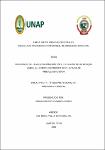Inventario de la vegetación existente en claros de un bosque varillal húmedo, producida por la caída de árboles en CIEFOR
Abstract
En el bosque varillal de Puerto Almendra, de la Universidad Nacional de la Amazonía Peruana se realizó un inventario de la regeneración natural en los claros producidos por la caída de árboles, con el objetivo de estudiar la riqueza, diversidad, equidad, dominancia y abundancia de las especies forestales.
En este bosque existe una alta actividad antrópica, registrándose claros desde 15 m2 hasta 169 m2 de área. 33172 individuos/ha de regeneración natural; la regeneración natural de Neea microphylla “palometa huayo” fue 3469 individuos/ha, Haplocrathra cordata“boa caspi” 3324 individuos/ha, Sloanea latifolia“achiotillo” tuvo 2364 individuos/ha, Aniba panurensis“moena” 2259 individuos/ha, Inga alba“shimbillo” con 2027 individuos/ha y Pagamea sprusei“sachahuito” con 1770 individuos/ha. Las especies en la zona de la copa presentaron un índice de diversidad de Margalef de 5,888; en la zona de raíz fue 6,288 y en la zona del tronco 6,734; el índice de Menhinick fue 0,5609; 0,5861 y 0,5611 para cada una de las zonas respectivamente. El Índice de Shannon-Wiener fue 3,261 en la copa, en la zona de la raíz 3,345 y en la zona del tronco 3,425. El índice de Simpson fue 0,0558 en la zona de la copa, en la zona de la raíz 0,0531 y en la zona del tronco 0,0485 La diversidad florística es diferente entre zonas de claro (t student; p valor = 0,000). Las abundancias de la regeneración natural entre las zonas del claro fueron similares (ANOVA F=2,289; Gl zonas del claro=2; p valor=0,102). In Puerto Almendra varillal forest of the National University of the Peruvian Amazon, an inventory about natural regeneration of trees that fall by themselves was made in order to study the richness, diversity, equity, dominance and abundance of forest species.
There is an anthropic activity in this kind of forest taking into place areas without trees starting from 15 m2 to 169 m2.
33172 trees per hectare by natural regeneration; a natural regeneration from Neea microphylla, well known as “palometa huayo” were 3469 trees per hectare, from Haplocrathra cordata well known as “boa caspi” were 3324 trees per hectare, Sloanea latifolia well known as “achiotillo” had 2364 trees per hectare, from Aniba panurensís well known as “ moena” were 2259 trees per hectare, from Inga alba well known as “shimbillo” were 2037 trees per hectare and Pajama sprusei well known as “sachahuito” with 1770 trees per hectare.
All tree species had shown at the top area a diversity rate of Margalef of 5,888; at the root area was 6,288 and at the trunk area was 6,734.
The Menhinick rate was 0,5609;0,5861 and 0,5611 for each of the zones respectively.
The Shannon-Wiener rate was 3,261 at the top of the tress, at the root area was 3,345 and at the trunk area was 3,425. The Simpson rate was 0,0558 at the tree top area, at the root area was 0,0531 and at the trunk area was 0,0485.
The floristic area is different between three zones (t student; p valor = 0,000).
The abundance of natural regeneration between areas without tress were similar (ANOVA F = 2,289; GI clear zones = 2; p valor = 0,102).
Collections
- Tesis [525]
The following license files are associated with this item:


